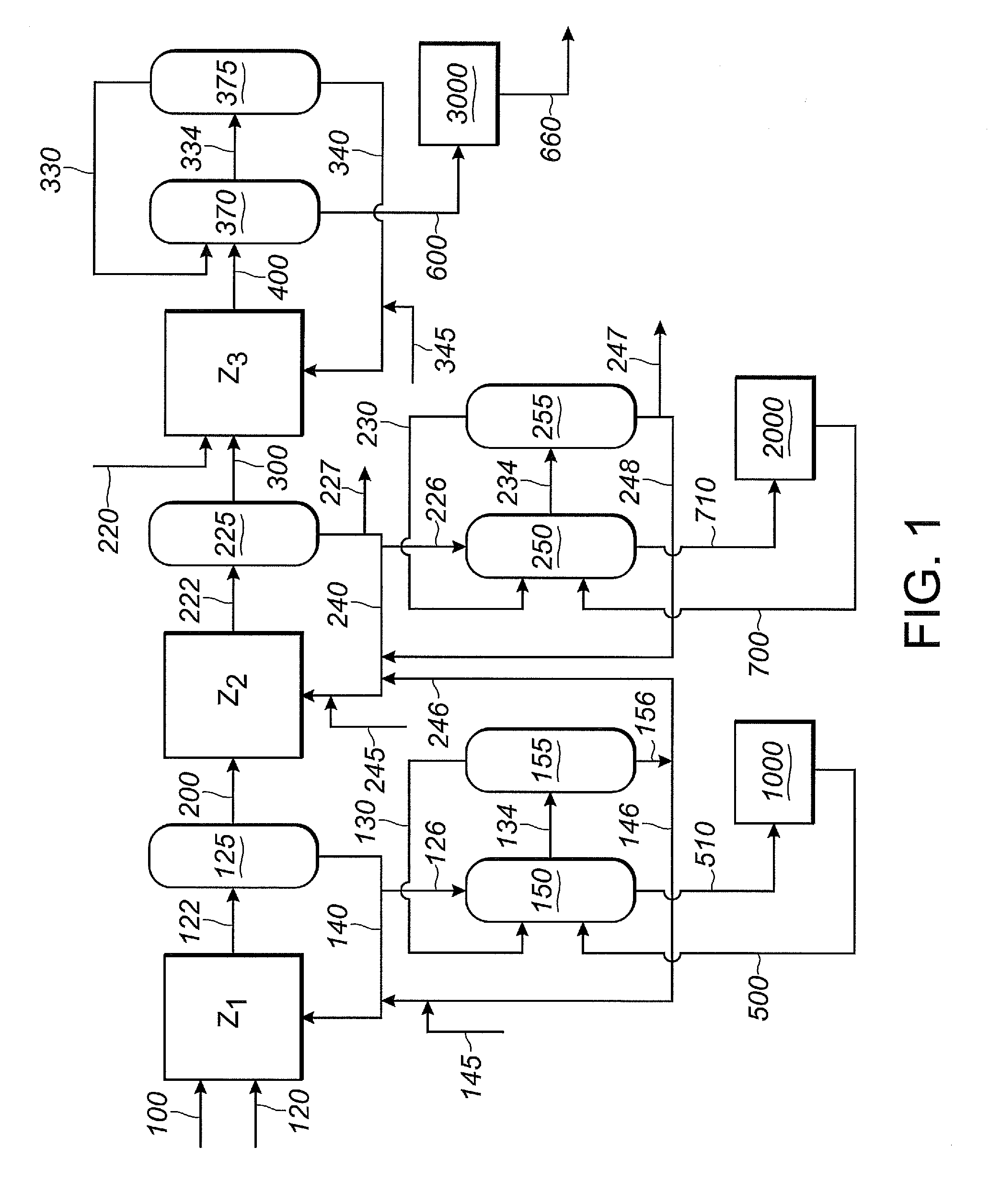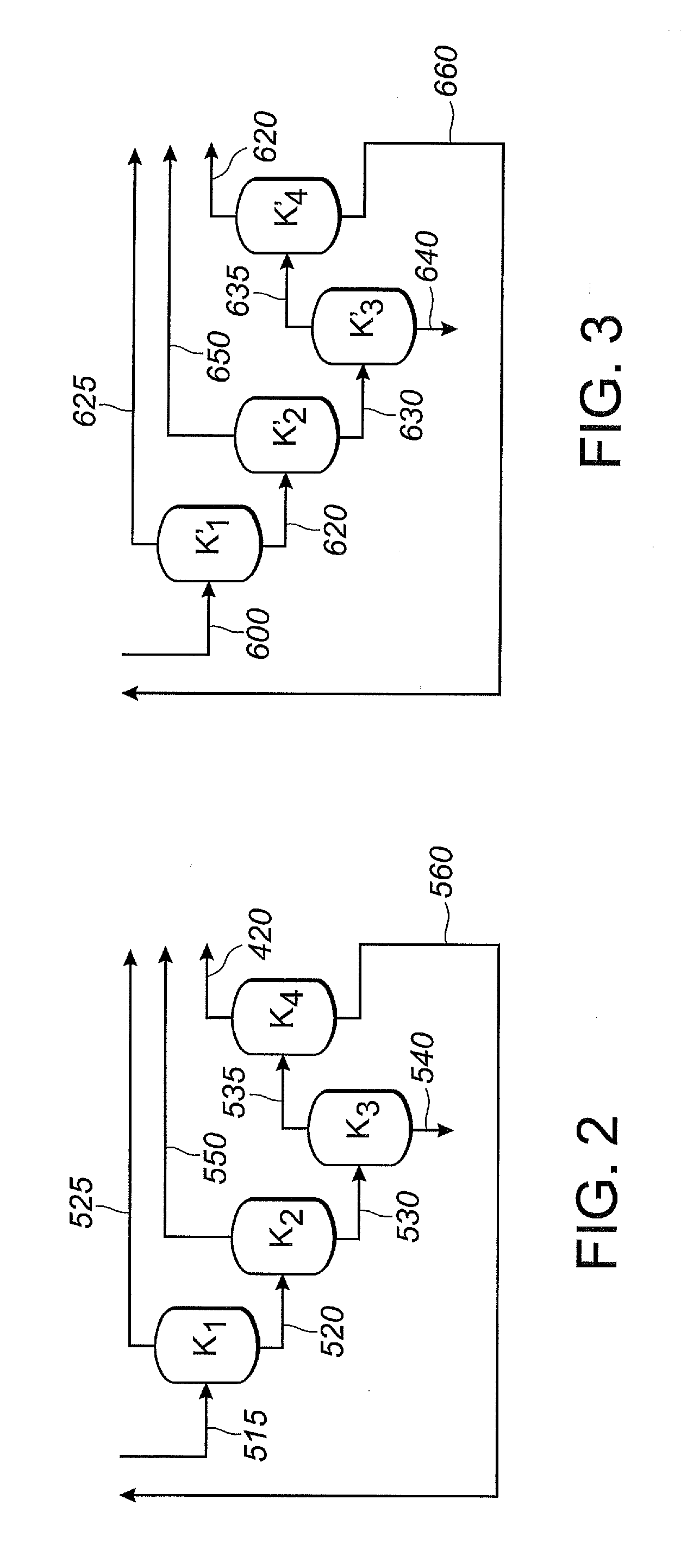Process for making nitriles
a technology of nitrile and nitrile, which is applied in the preparation of carboxylic acid nitrile, organic compound preparation, carboxylic acid nitrile, etc., can solve the problems of reducing the reaction efficiency, reducing the effective reactor volume, and reducing the buildup of catalyst degradation products. , the effect of reducing the accumulation of reaction byproducts
- Summary
- Abstract
- Description
- Claims
- Application Information
AI Technical Summary
Benefits of technology
Problems solved by technology
Method used
Image
Examples
example 1
Operating Paramters and Results
[0371]Nickel dosage is maintained at about 500 ppm weight (based on total feed) in the first reaction zone (Z1). Ligand dosage is controlled at around 3:1 molar ratio of bidentate Iigand:nickel.
[0372]Catalyst loss is observed when the bottoms (process side of the reboiler) operating temperature in the butadiene column (the first distillation column after the first reaction zone) exceeds about 125° C. While not to limit the scope of the invention by a recitation of theory, it is believed that the loss of the bidentate ligand component of the catalyst is due to thermal degradation. To maintain ligand inventory, the butadiene column bottoms (the first column after the first reaction zone) is controlled at at 125° C. Initially, this results in an unacceptably high level of unreacted butadiene in the pentenenitrile-enriched bottoms product. In an attempt to solve this problem, the butadiene column is upgraded for vacuum operation, and refrigeration equipmen...
example 2
Segregated Catalyst Recovery Systems
[0374]This Example 2 illustrates segregated catalyst recovery systems. In particular, this Example 2 illustrates a process using three separate catalyst recovery systems where each of reaction zones Z1, Z2 and Z3 contain catalyst comprising nickel and a bidentate phosphite-containing ligand having the structure of Formula III, above.
[0375]In this Example 2, as shown in FIG. 1, 1,3-butadiene reactant is fed into the first reaction zone (Z1) through line 100, hydrogen cyanide reactant is fed into the first reaction zone (Z1) through line 120, and catalyst is fed into the first reaction zone (Z1) through line 140. A reaction product stream is taken from the first reaction zone (Z1) through line 122. The reaction product stream in line 122 comprises products, byproducts, unreacted reactants and catalyst, which flows through the first reaction zone (Z1). The reaction product stream 122 is introduced into a separation section 125, to obtain, inter alia,...
example 3
Segregated Catalyst Recovery Systems
[0415]Example 3 illustrates partially segregated catalyst recovery systems with monodentate ligand in the Z1 / Z2 catalyst loops and bidentate ligand in the Z3 catalyst loop where the Z1 and Z2 catalyst loops share a first catalyst recovery section and the Z3 catalyst loop has a dedicated second catalyst recovery system. In this Example 3, the Z1 / Z2 catalyst recovery section and the Z3 catalyst recovery section are segregated to minimize flow of the monodentate ligand of Z1 / Z2 into the bidentate ligand of Z3, and the bidentate ligand and Lewis acid of Z3 into the monodentate ligand of Z1 / Z2.
[0416]For this Example 3, Example 2 is repeated, except that the first reaction zone (Z1) and the second reaction zone (Z2) share a single catalyst recovery system, not shown in FIG. 1. A shared catalyst recovery system may be desirable when the first and second phosphite-containing ligands are the same, as is the case in this Example 3, where both Z1 and Z2 use ...
PUM
| Property | Measurement | Unit |
|---|---|---|
| boiling point | aaaaa | aaaaa |
| chemical yield | aaaaa | aaaaa |
| concentration | aaaaa | aaaaa |
Abstract
Description
Claims
Application Information
 Login to View More
Login to View More - R&D
- Intellectual Property
- Life Sciences
- Materials
- Tech Scout
- Unparalleled Data Quality
- Higher Quality Content
- 60% Fewer Hallucinations
Browse by: Latest US Patents, China's latest patents, Technical Efficacy Thesaurus, Application Domain, Technology Topic, Popular Technical Reports.
© 2025 PatSnap. All rights reserved.Legal|Privacy policy|Modern Slavery Act Transparency Statement|Sitemap|About US| Contact US: help@patsnap.com



